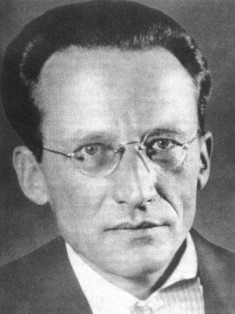| Erwin Schrodinger | |
|---|---|
 |
|
| Physicist | |
| Specialty | Quantum theory, wave mechanics |
| Born | Aug. 12, 1887 Vienna, Austria-Hungary |
| Died | Jan. 4, 1961 (at age 73) Vienna, Austria |
| Nationality | Austrian |
Erwin Rudolf Josef Alexander Schrodinger was born on August 12, 1887 in Vienna, Austria. His activity in physics got him classified as an influential quantum theory pioneer, formulating the wave equation and developing formalism and the matrix mechanics. During his life, he published many papers on statistical mechanics, color theory, thermodynamics, general relativity and cosmology.
Early Life
In 1906, Erwin studied in Vienna until 1910 and only one year later he accepted a position as an assistant to Franz S. Exner. Even at an early age, Schrodinger was fascinated by Schopenhauer who influenced him and led to his development of the color theory.
Despite being raised in a religious environment, Erwin Schrodinger grew to be an atheist. However, he used religious symbolism on a frequent basis in his works and expressed a personal interest for eastern religions and pantheism. According to Schrodinger, his work and research represented a metaphorical approach to what he defined as God.
Academic Career
In 1914, Erwin managed to achieve Habilitation, the highest academic graduation that a student can obtain. Soon after, when World War I started, he was enrolled as an officer in the Austrian army. His academic career continued in 1920 when he became the assistant of Max Wien and later on that year he became an associate professor in Stuttgart. Just one year later he moved up to become a full professor in Worclaw, Poland, and then moved to a university in Zurich soon after that.
Schrodinger decided to leave Germany in 1934 due to his dislike of the Nazi’s anti-Semitism. The University of Oxford accepted him as a Fellow of Magdalen College and not long after that, he obtained a Nobel Prize. He turned down an offer for a permanent position at Princeton University after holding a lecture. During his stay in England, Schrodinger was debating various topics with Albert Einstein and came up with the Schrodinger’s cat experiment in 1935.
He had to leave England due to visa delays and in 1936, Erwin returned to Austria and accepted a position at the University of Graz. Due to this unforeseen problem, he was forced to turn down a position at the University of Edinburgh.
His opposition to anti-Semitism and Nazism got him to be harassed and forced to move to Italy for a while and ended up working in Dublin in 1940 as the Director of the School for Theoretical Physics. He remained in Dublin until he retired in 1955 and returned to Vienna just one year later.
Contributions to Physics
 In 1921, Schrodinger finished working on his first paper on atomic theory. Using mathematical methods, the physicist was able to demonstrate that quantum orbits have certain geometric properties. He was able to analyze the orbits of the electron within an atom using a generic point of view. His study served as a basis for the wave mechanics that was published in 1926 in his paper named “Annalen der Physik.”
In 1921, Schrodinger finished working on his first paper on atomic theory. Using mathematical methods, the physicist was able to demonstrate that quantum orbits have certain geometric properties. He was able to analyze the orbits of the electron within an atom using a generic point of view. His study served as a basis for the wave mechanics that was published in 1926 in his paper named “Annalen der Physik.”
His study was considered one of the biggest achievements of the 20th century. Schrodinger continued his work and only four weeks later, he managed to solve the rigid rotor, the dynamic molecule and the quantum harmonic oscillator. Schrodinger continued the elaboration of his theories and explained the Doppler Effect using mathematical equations.
All his findings were based on the Schrodinger equation which is still used today. Amongst his papers published in this period, the fourth one was recognized as his most important studies according to the physics community.
Schrodinger’s work also included color perception and colorimetry. Three papers were published on this topic in 1920. The second one was included in the Sources of Color Science, published by MIT press.
Schrodinger’s Legacy
Schrodinger died on January 4, 1961 in Vienna. At the age of 73, the scientist fell victim to tuberculosis after surviving the disease several times during the 1920s.
One of the most debated philosophical problems that the physicist developed is Schrodinger’s cat. Even today, the controversy of this philosophical experiment is a popular topic for scientists. However, his most notable achievement is the Schrodinger equation which got him known as one of the founding fathers of quantum physics. As recognition for his contributions to science, the larger crater on the far side of Earth’s Moon has been given his name.
The University of Limerick named one of its buildings Erwin Schrodinger in honor of his contributions. His 126th anniversary was celebrated even by Google with a doodle on its front page.